If you are in need of foundation support or stabilization, you may have heard of helical piers. These innovative structural elements have gained popularity in recent years due to their flexibility, low-environmental impact, and cost-effectiveness. In this article, we will explore the benefits of helical piers in detail, including their components, how they work, advantages, and various applications.
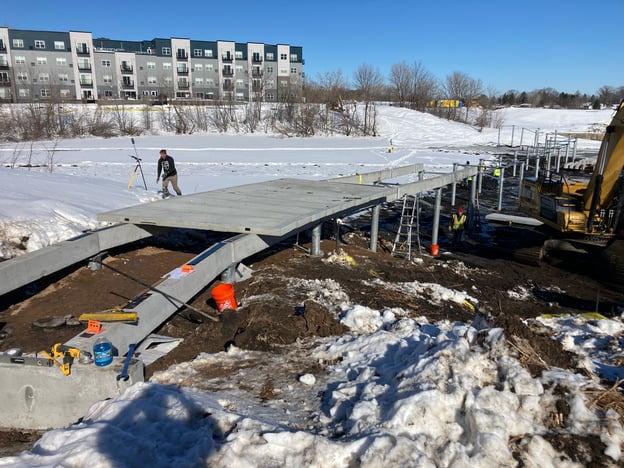
Boardwalk being installed on a helical pier foundation.
What are Helical Piers?
Helical piers, sometimes called helical piles or screw piles, are foundational supports that have been used in construction for over a century. They are a popular alternative to traditional concrete foundations due to their ease of installation, versatility, and low environmental disturbance. Helical piers are comprised of a primary steel shaft with helical plates welded to the shaft. These plates, also known as helixes, are what make helical piers unique and effective. The helixes allow the pier to be screwed into the soil, similar to a screwdriver turning a screw.
Helical piers have a wide range of applications, from residential homes and commercial buildings to bridges and even lighthouses. They can be used in both new construction and retrofitting projects, making them a versatile choice for any type of foundation.
Components of Helical Piers
Helical piers are typically composed of three parts: the shaft, the helices, and the bracket. The shaft is the long steel rod that is screwed into the soil. The steel shafts may be round or square and are typically manufactured in section lengths of 5 ft. to 7 ft. The shaft sections are bolted together (see example below).
The helix is a circular plate that is welded to the lead section of the shaft. The size and number of helices used will depend on the load that the pier is intended to bear. Finally, the bracket is what connects the pier to the structure that requires support. The bracket can be customized to fit the size and shape of the structure.
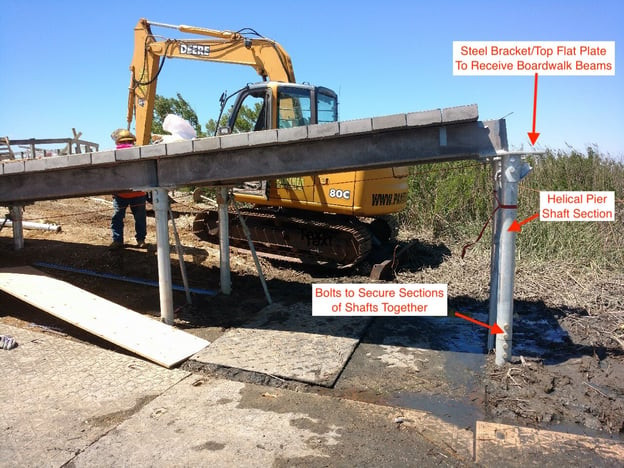
Diagram of helical pier components, including the steel bracket and shaft sections.
The materials used to make helical piers are carefully chosen to ensure maximum strength and durability. The steel used in the shaft is typically a high-strength alloy that can withstand the weight of the structure it supports. The helixes are also made of steel, and their size and shape are carefully chosen to provide the necessary support while minimizing the impact on the surrounding soil.
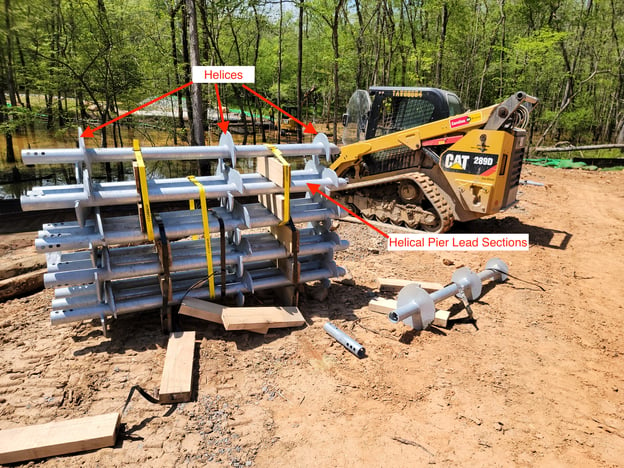
Image showing the helices and helical pier lead sections.
How Helical Piers Work
A helical pier works by utilizing the strength and stability of the soil. The helices at the section of the shaft have a larger surface area than the shaft alone, which allows them to distribute the load of the structure over a larger area of soil. This results in a deeper, more stable foundation. Additionally, the helical piers can be installed quickly, utilizing relatively small equipment, and without creating significant disruption to the surrounding area.
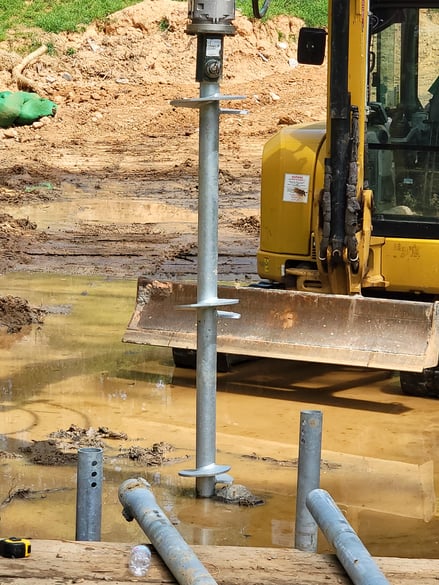
Helical pier lead sections being installed with small equipment.
In addition to their strength and stability, helical piers offer several other benefits. They are resistant to corrosion and can last for decades without needing to be replaced. They are also environmentally friendly, as they do not require the use of heavy machinery or the excavation of large amounts of soil.
Overall, helical piers tend to be a reliable and cost-effective solution for any construction project that requires a strong and stable foundation.
Advantages of Using Helical Piers
Speed and Efficiency
One of the biggest advantages of using helical piers is their speed and efficiency. Unlike traditional foundations, such as timber piles, drilled shafts or driven concrete piles, helical piers can typically be installed much more quickly. In order to install driven pile foundations, this requires large equipment with pile driving leads attached. This can make driven piles more time-consuming to install. Alternatively, helical piers can be installed using lightweight equipment, which reduces the amount of disruption to the surrounding area and allows for easier access to tight spaces.
For example, if you're building a deck or a small addition to your home, helical piers can be installed in just a few hours. This means that your project can be completed much faster, and you can start enjoying your new space sooner.
Minimal Environmental Impact
Another advantage of helical piers is their minimal environmental impact. Traditional foundation supports often require the use of heavy machinery and excavation, which can damage or disturb the surrounding landscape. This is not the case with helical piers. Helical piers are installed using small equipment, which means that the surrounding landscape is less likely to be damaged or disturbed during installation.
Additionally, helical piers do not produce any waste materials (spoils) or require the use of potentially harmful chemicals, making them an environmentally friendly option. This is especially important if you're building in an area with sensitive ecosystems or if you're concerned about the environmental impact of your project.
Cost-Effectiveness
Helical piers are a cost-effective alternative to traditional foundation supports. They require less labor and equipment to install, which can result in significant cost savings. Additionally, they can be installed in any weather conditions, which allows for more flexibility in scheduling and reduces the risk of delays or unexpected costs.
Furthermore, helical piers can be easily removed and reused if you decide to move your structure or make changes to your foundation. This can save you even more money in the long run.
Versatility in Various Soil Conditions
Helical piers can be installed in a variety of soil conditions, including clay and dense sand. They can also be installed on slopes or in areas with limited access. This makes them a versatile option for a wide range of applications.
Load-Bearing Capacity
Finally, helical piers have an excellent load-bearing capacity, making them suitable for a wide range of structures. They can bear both vertical and horizontal loads, and can support structures in areas with high water tables or other challenging soil conditions.
This means that helical piers can be used to support everything from small decks and additions to large commercial buildings and bridges. They provide a reliable and long-lasting foundation support option that can withstand even the most challenging conditions.
Applications of Helical Piers
Helical piers are a versatile and reliable solution for a wide range of construction and engineering challenges. From new construction projects to foundation repair, slope stabilization, retaining walls, boardwalks, and bridges, helical piers offer a range of benefits that make them an ideal choice for many different applications.
Foundation Repair
If your foundation is experiencing settlement, cracking, or other issues, helical piers can be an effective solution to stabilize and repair the structure. Helical piers can be installed with minimal excavation, reducing the disturbance to the surrounding area and minimizing the impact on your daily life.
Additionally, helical piers are a long-lasting solution that can help to prevent future foundation issues. By providing a stable and reliable foundation, helical piers can help to extend the lifespan of a structure, ensuring its safety and stability for years to come.
Slope Stabilization
Helical piers can be used to provide stability to slopes or embankments that are at risk of movement or erosion. By installing helical piers in a strategic pattern, engineers can create a stable foundation that can resist the forces of gravity and prevent soil movement.
In this diagram from Foundation Technologies, helical tieback anchors are installation into retained soil.
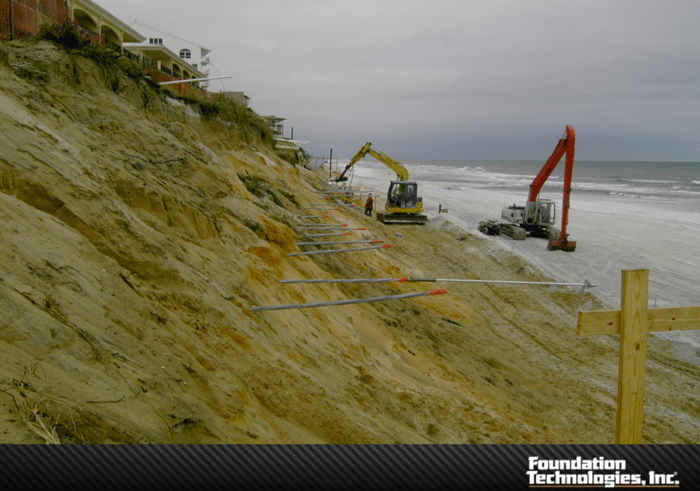
Slope stabilization example from Foundation Technologies.
Moreover, helical piers are a minimally invasive solution that can help to preserve the natural environment around the slope or embankment. Because helical piers can be installed without excavation or the need for heavy equipment, they can be used in areas where traditional foundation solutions would be impractical or impossible.
Retaining Walls
Retaining walls are an important component of many construction projects, providing support and preventing soil erosion. Helical piers can be used to provide additional stability to retaining walls, ensuring that they remain safe and effective over time.
Because helical piers can be installed quickly and with minimal excavation, they are an ideal option for retaining wall support. Additionally, helical piers are a cost-effective solution that can help to reduce the overall cost of your construction project.
Boardwalks and Bridges
Boardwalks and bridges are essential infrastructure components that provide safe and reliable access to natural areas, parks, and other public spaces. However, building boardwalks and bridges in challenging soil conditions can be a difficult task.
Helical piers can be used to support boardwalks and bridges in areas with limited access or challenging soil conditions. Boardwalks are commonly constructed in wetlands, which typically requires that the foundation poses minimal disturbance to the environment.
When building a boardwalk over wetlands or an environmentally sensitive area, top-down construction might be something suggested ,or even required by the municipality or agency leading the project. In this case, helical piers are an excellent foundation option when top-down construction is required.
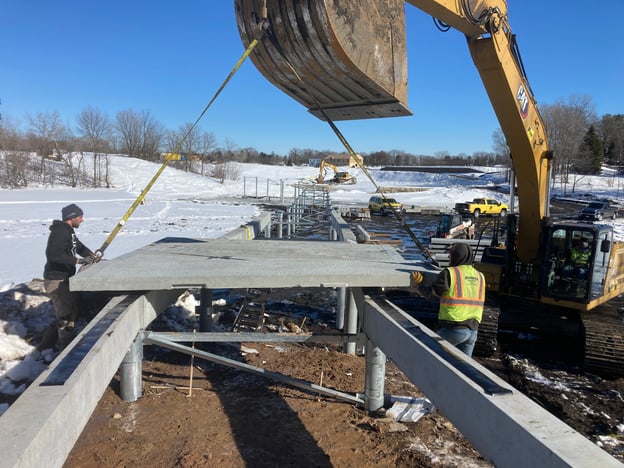
Example of a boardwalk being installed with a helical pier foundation: Thompson Oaks Greenway in Minnesota
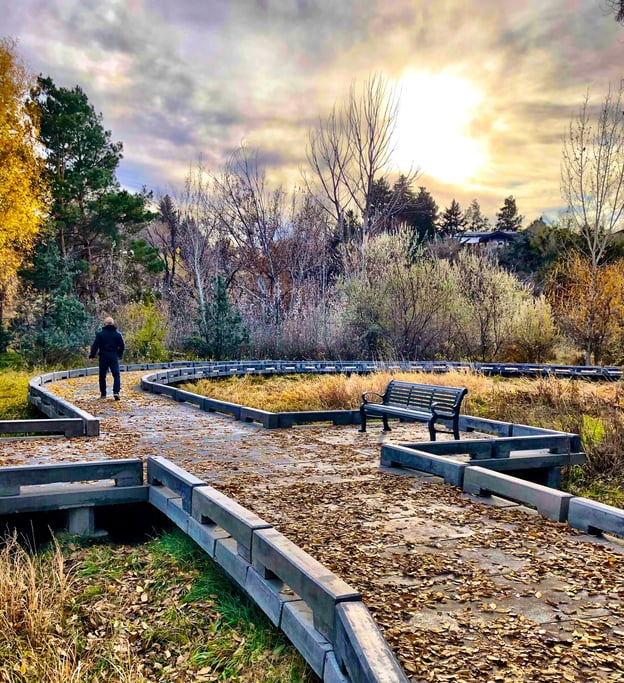
Example of a completed helical pier boardwalk application: Kathyrn Albertson Park in Idaho
Conclusion
Helical piers offer a wide range of benefits and applications for those in need of foundation support and stabilization. From new construction to foundation repair, retaining walls, and boardwalks, helical piers are a versatile, durable, and cost-effective option. Understanding the benefits of helical piers can help you make an informed decision when it comes to protecting your property and structures.




